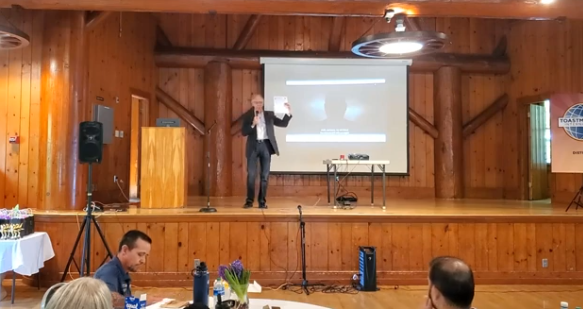The Power of the Pause: The Secret Sauce of Great Public Speaking
This presentation is all about a crucial tool in public speaking that is missing from Toastmasters:
The Pause.
In this presentation, I demonstrate the importance of pauses in everything from telling a joke to playing music. You may find it helpful to first download the Pause Counter form with the explanation of pause types so you have it to follow along while listening. http://bit.ly/pausecounterform
Pauses are found in many places. A long distance swimmer pauses between strokes to go further faster. In music, there may be many notes played at one time, but when a rest note is played, it stands alone. Driving in traffic, a stop sign creates a pause to add safety. When you look for them, you can find pauses everywhere in our world. Pauses are the natural substitute for that infamous Toastmaster Taboo: the filler word. Elimination of filler words is a good goal, but Toastmasters has put the focus on the problem, not the solution. What if, instead of focusing on what to avoid — the filler words — we focus on what we want in their place — pauses? If you focus on adding pauses, the filler words will naturally disappear.
Not all pauses are created equal. There are many different types of pauses which I have been able to separate into 2 categories: Incidental and Intentional.
Incidental pauses are those that come naturally and are used in conversational speech. They generally give the speaker a chance to breathe or to think. They are usually dictated by punctuation, such as commas, semicolons, periods, question marks. Incidental pauses are also used as a replacement for a filler word – or rather, a filler word is often used where a pause belongs. This is “the silent filler.” These pauses are essential to being clearly understood and a basic part of speaking. The Ah-counter in Toastmasters is essentially focused on these, but instead of listening for pauses, they are listening for when pauses are replaced with filler words.
Intentional pauses make up the second category of pauses. These are the pauses that serve a greater purpose than just giving the speaker time to breathe or think. These pauses add seasoning and spice to your words. Most people go through their day never using these pauses. But if you listen carefully, you will find that the most interesting people tend to use many of these pauses as a staple part of their vocabulary.
Types of Intentional Pauses
Here is a breakdown of the different types of intentional pauses that I have identified so far. I’m sure as you study and observe, you will come up with more of your own, either nuanced differences from these or entirely new styles of pauses. If you have an idea, post it in a comment.
Pre-emptive Pause: Pause before starting to speak. This allows the speaker to gather their thoughts as
well as draw in the attention of the audience. A powerful start to any speech. Extend this pause for 5 or more seconds to build anticipation in your audience. Remember in Toastmasters, the timer doesn’t start until you start talking.
Punchline Pause: Humor has more impact when a pause is made before delivering the punchline. Watch a few standup comedians online to see how they use pauses. A wonderful example can be found in this performance by Stomp entertainment group. Their silence is palpable and the pause itself even becomes the punchline.
Audience Pause: Also known as Laugh Pause and Applause Pause. This is used to give the audience
time to react. Generally, the larger the audience, the longer the Pause. Do not step on their reaction or
cut it short. Like popping popcorn – It’s not done until it slows down enough, but don’t overcook it.
Thoughtful Pause: Allows the audience time to digest what was just said. In storytelling, it allows them
time to use their imagination; in technical talks, it allows them time to understand.
Emphatic Pause: Used to add emphasis to what precedes or follows the pause.
Indefinite Pause: When Finished speaking or when waiting for the listener to respond. Do not speak again until the listener responds. It is very important to not give in and speak first if the audience doesn’t respond as quickly as you expect. Get comfortable with this one so you can let it get uncomfortable for the listener. This is especially useful in negotiations. This specific usage is described in the book “Never Split the Difference” by Chris Voss.
Here are a few more resources that I mentioned in my video presentation above. These are 3 winners of the International Speech Contest, so they should be a great way to practice counting the various pauses. Even among winning speeches, I think you will find a direct correlation between the number and length of the pauses and the perception of the speech. You can do this with any speech. For comparisons, try to use speeches of similar lengths. That is where contest speeches are handy. They are all 5-7 minutes. Also be aware that speeches given to an online-only audience won’t have any audience pauses. Those only occur with a live audience in the room. This is why talk shows are “filmed before a live studio audience” and why sitcoms have laugh tracks. This is also why I am a strong advocate for practicing your speaking before a live audience. If all you do is speak to a camera, you are missing out on the most important part of Public Speaking: the audience.
You might also check out the second video on my 2019 blog post showcasing the Stomp acting group video demonstrating pauses.
In fact, pauses can be treated as words in your vocabulary. The more types of pauses you learn, the more fluent your vocabulary will become. Shift the focus from what to avoid — filler words — to what you want to include — pauses — and watch how quickly your public speaking improves.
Call To Action:
– Share this with your Toastmasters club and friends.
– Create a Pause Counter meeting role for your club meetings.
– This is just getting started. Add your suggestions for growing Pauses in the comments below.
You might enjoy these related blog posts:
Video: Stomp performers are masters of body language and pauses
Video: 20 Things You Forgot About Giving Speeches in Person
Video: Worst (and Best) Practices for Giving Speeches Online

The Power of the Paws, inspired by and in memory of Freddy the Bassett.

Posted on February 27, 2024, in toastmasters, Uncategorized and tagged communication, Pause, speaking, speech, toastmasters, writing. Bookmark the permalink. Leave a comment.

Leave a comment
Comments 0